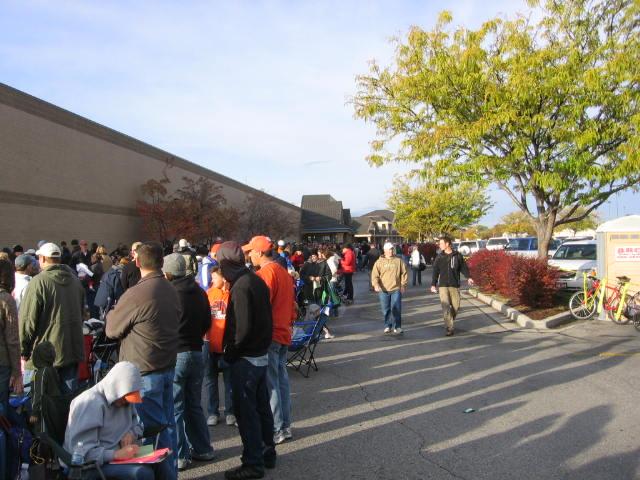Powerful computer models help researchers react to pandemic spread
High-risk groups line up at a defunct Kmart for the first H1N1 vaccinations publicly available in Boise, Idaho, Oct. 24, 2009. (Photo by Kencf0618 via Wikimedia Commons, cc-by-sa.)
High-tech video games may be the latest weapon for scientists in their battle to fight drug-resistant bacteria. Sort of.
Scientists at Virginia Tech University have developed a computer model that helps researchers track pandemics around the world. It could give them new ways to determine why one disease spreads and another one peters out.
Take swine flu. Some 33 soldiers on a U.S. Army base contracted it back in 1976 and one person died. But the disease never spread. In 2009, swine flu, also known as H1N1, came back. It tore around the globe, infecting 61 million people, and killing 12,000.
One way to understand how a disease could spread is to computerize the situation, and see what happens with an artificial population. During the 2009 outbreak, U.S. health officials used the Virginia Tech computer model, called EpiSimdemics, to test and predict what H1N1 would do in the population.
Christopher Barrett, one of the EpiSimdemics project leaders, said the model is a way to generate a in-person social network based on how real people interact with one another. To do that, the computer uses official U.S. census data, gives people jobs based on statistical surveys and then defines how they move about their world, also based on information gleaned from real people.
“So if they were going to drive, for example, you might need models of traffic – detailed traffic – with every individual in a vehicle or in a bus or something so that you can figure out where they are, who they’re next to.” Barrett said.
Once that’s done, a disease, everything from the regular flu to HIV, can be introduced to the population and its spread can be tracked.
Computer scientist Madhav Marathe said part of what’s innovative about the model is it tries to account for how people’s behavior will change in the face of a pandemic.
“The individual behaviors, the disease and the social contact network all change in response to each other,” he explained. “For instance, I decide not to go to work, or I decide to get antivirals, or decide not to send my child to work. This in effect changes how the disease continues to move.”
The simulation can’t tell exactly what’s going to happen in a pandemic. But public health officials can tweak the model, for example they can introduce a school closure or make a vaccine available, and see how it affects things. That gives them a good overall understanding of what can happen and what can go wrong.
In 2009, it helped the government plan for how to deal with H1N1.
“The question that we were posed, along with other groups, was — if you’re given this small quota of vaccines, how do you decide whom to vaccinate?” Marathe said. “And remember that the decision has to be done under the following different criteria: how many people do you save, how much control you can achieve from the disease, what’s the potential economic impact, how can you save critical workers so the society can keep functioning and so on.”
In the end, computer models like these might not stop a disease in its tracks, but they can certainly help save lives.
